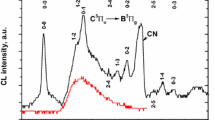Summary
We have studied radiation damage in KCl crystals doped with Sr++ using thermoionic-current techniques (ITC) and optical-absorption measurements. Analysing the radiation damage due to three different gamma-ray exposures, we confirmed the results obtained by other authors, namely the gamma irradiation createsF-type orV-type colour centres and destroys a fraction of impurity-vacancy dipoles. Fastneutron irradiation added to the gamma irradiation increases the efficiency of destruction of dipoles. The fast neutrons also provoke the appearance of a second ITC peak at temperatures near 123°K, which is unstable and disappears in a few days. On the other hand thermal neutrons bombarding the samples together with fast neutrons and gamma-rays leave unchanged the impurity-vacancy dipole concentration obtained after the gamma plus fast neutron irradiation. With thermal neutrons there is a high background current, and the peak resolution is only possible when thermally and electrostatically polarizable electrical carriers have largely disappeared. For this reason it is impossible to compare the 123°K peak obtained with and without thermal neutrons.
Riassunto
Si è studiato il danno provocato dalle radiazioni in cristalli di KCl con impurezze di Sr++ con la tecnica delle termocorrenti ioniche (ITC) e con misure di assorbimento ottico. Analizzando il danno provocato da tre differenti esposizioni a radiazioni gamma, si sono osservati i risultati predetti da altri autori, cioè che la radiazione gamma crea centri di colore del tipoF eV, e distrugge una frazione di dipoli impurezza-vacanza. Irraggiamenti simultanei con neutroni rapidi e radiazione gamma provocano una maggior distruzione di dipoli. I neutroni rapidi provocano anche la comparsa di un secondo picco di ITC a una temperatura di 123°K; questo picco è instabile e scompare dopo alcuni giorni. La concentrazione di dipoli impurezza-vacanza ottenuti dopo l’irraggiamento con gamma più neutroni rapidi rimane inalterata quando sono presenti anche neutroni termici. I neutroni termici danno luogo a una corrente di fondo molto alta che rende impossibile distinguere il picco di ITC; questo perdura finché la concentrazione dei portatori di cariche elettriche che possono essere polarizzati diventa trascurabile. Questo fatto rende impossibile il confronto tra il picco di ITC a 123°K ottenuto nell’irraggiamento con neutroni rapidi e quello ottenuto con l’aggiunta di neutroni termici.
Резюме
Используя технику термоионных токов и измерения оптического поглощения, мы исследовали радиационные повреждения в кристаллах KCl с присадкой Sr++. Анализируя радиационные повреждения, обусловленные тремя различными экспозициями гамма-лучей, мы подтверждаем результаты, полученные другими авторами, а именно, гамма-облучение создает цветные центрыF-типа илиV-типа и уничтожает часть диполей «примесь-вакансия». Облучение быстрыми нейтронами вместе с гамма-облучением увеличивает интенсивность уничтожения диполей. Быстрые нейтроны также приводят к появлению второго пика термоионного тока при температурах вблизи 123°K. Этот пик является нестабильным и исчезает через нескольно дней. С другой стороны тепловые нейтроны, бомбардирующие образцы вместе с быстрыми нейтронами и гамма-лучами, оставляют неиз-менной концентрацию диполей «примесь-вакансия», полученную в результате облучения гамма-лучами и быстрыми нейтронами. В случае тепловых нейтронов существует сильный фоновый ток и разрешение пиков возможно только тогда, когда термически и электростатически поляризуемые электрические носители, в основном, исчезают. По этой причине невозможно сравнить пик при 123°K, полученный с и без тепловых нейтронов.
Similar content being viewed by others
References
L. W. Barr andA. B. Lidiard:Physical Chemistry, An Advanced Treatise, Vol.10 (New York, N. Y., 1970), p. 152.
C. Bucci andR. Fieschi:Phys. Rev. Lett.,12, 16 (1964).
R. Capelletti andR. Fieschi:Electrets (Princeton, N. J., 1973).
M. Beltrami, R. Capelletti andR. Fieschi:Phys. Lett.,10, 279 (1964).
C. Laj andP. Berge:Journ. Phys. Chem. Sol.,30, 845 (1969).
J. P. Stott andJ. H. Crawford jr.:Phys. Rev. B,6, 4660 (1972).
D. S. Billington andJ. H. Crawford jr.:Radiation Damage in Solids (Princeton, N. J., 1961).
M. Nishi, M. Ikeda, A. Fujii andS. Kato:Memoirs of the Faculty of Engineering, Hiroshima University,4, No. 1, serial No. 12, 23 (1970).
J. H. Crawford jr.:Adv. Phys.,17, 93 (1968).
P. W. Levy:Phys. Rev.,129, 1076 (1963).
G. H. Kinchin andR. S. Pease:Rep. Prog. Phys.,18, 1 (1955).
G. J. Dienes andG. H. Vineyard:Radiation Effects in Solids (1957), p. 6–53.
A. A. Vorob'ev andB. Budylin:Sov. Phys. Solid State,2, 615 (1960).
J. Petiau: Thesis,Etude des défauts ponctuels dipolaires dans le fluorure de lithium par relaxation dielectrique, Faculté des Sciences de l'Université de Paris (1966).
L. F. C. P. Lima, S. Koshimizu andG. Guenin:Ciência e Cultura,25, No. 6, Sup. 12 (1973).
Author information
Authors and Affiliations
Additional information
To speed up publication, the authors of this paper have agreed to not receive the proofs for correction.
This work was supported partly by Comissão Nacional de Energia Nuclear and partly by Conselho Nacional de Pesquisas.
In partial fullfilment of the requirements for PhD degree.
Переведено редакцией.
Rights and permissions
About this article
Cite this article
Sordi, G.M., Watanabe, S. Ionic thermocurrent and optical-absorption measurements in KCl∶Sr under reactor irradiation. Nuov Cim B 25, 145–158 (1975). https://doi.org/10.1007/BF02737670
Received:
Revised:
Published:
Issue Date:
DOI: https://doi.org/10.1007/BF02737670




